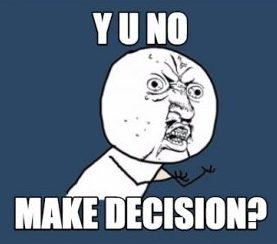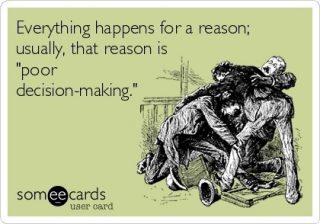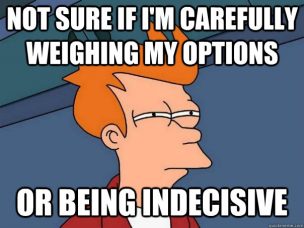How to Use a Decision Matrix
Learn how to build a qualitative or quantitive decision matrix, how to add weighting to your options, and use an objective approach to come to an informed, intentional decision.

We make thousands of decisions every day. They vary in importance from what we will wear and have for lunch to (sometimes) life decisions about our jobs, families or futures. Most decisions we make on the fly and are not actively aware that a decision is even being made. They are passive, routine, and habit-oriented and generally require little energy.
What about big, complex, life-changing decisions? What about the decisions that are hanging over you and keeping you up at night? How can you make these big decisions in an informed, intentional way?
Try a decision matrix!
What is a decision matrix?

A decision matrix is a visual tool to help you evaluate the criteria of a decision in a holistic way. It is a process you can go through where you:
- List the potential decisions on the x-axis.
- List the decision criteria on the y-axis.
- Decide if the criteria are qualitative (can be observed but not measured numerically) or quantitative (measured numerically).
- Fill it out and evaluate the results.
You might not come to a decision immediately, but a decision matrix can help you narrow the options and clarify which criteria are actually important to you.
When to use a decision matrix
A decision matrix is a reasonable tool to try if:
- Your decision feels overwhelming because there are too many factors to hold in your head.
- You are flip-flopping on which direction to go and want to evaluate the potential decision options in an analytical way.

What a decision matrix does is give you the opportunity to organize your thoughts, feelings, and data in a structured way. You can brainstorm the things that have been floating around in your head and record them. A decision matrix puts all that information in one place so you have a visual layout of your options and, if quantitive, how they rank.
Decision matrices will not tell you which decision to make. What they will do is help you narrow the options and compare potential courses of action in an intentional way.
How to build a qualitative decision matrix

A qualitative decision matrix is useful when the decision you are trying to make has complex emotions and multi-dimensional criteria tied to it. The criteria will be things that can be observed, but not measured numerically. It will help give you the parameters to evaluate something that is subjective in a more objective way.
To build a qualitative decision matrix you can follow these steps:
- List the potential decisions on the x-axis.
- List the decision criteria on the y axis. These can be anything you want. Words, emotions, consequences, time, etc.
- Fill it out as honestly as you can.
- Summarize each decision based on your impressions of the criteria you listed for each decision.
An example of a qualitative decision is: Should I stay at my current job, try a new job, or go back to school for my Masters?
This is a significant, life-changing decision that will have far-reaching consequences. It is not an easy decision and has many different factors. This is the kind of decision where there isn’t really a “right” answer, but rather one that can be happily lived with. There are pros and cons to each direction but what the matrix does is collect all of the emotions and thoughts around the decision and put them in a single view so you can evaluate them as objectively as possible.
You can check out this example with the criteria filled in to get an idea of how to approach your own qualitative decision matrix.
How to build a quantitative decision matrix

A quantitative decision matrix is useful when the decision you are trying to make has measurable criteria. You will be able to apply a numeric measurement to the criteria you are basing the decision on. This is an analytical approach that will help validate your decision-making process and narrow down your options.
To build a quantitative decision matrix you can follow these steps:
- List the potential decisions on the x-axis
- List the decision criteria on the y axis. These might be effort level, cost, time to implement, etc.
- Create a measurement scale. I like 1, 2 or 3, with 1 being lowest/worst and 3 being highest/best.
- Fill out the numbers based on your scale.
- Add them up and see which one has the highest number.
An example of a quantitative decision is: What position should I hire for next?
Depending on the number of roles want to fill, this could have many factors to consider that could have significant implications for a business. This could easily be framed as an emotional decision, but it probably shouldn’t be. The criteria to measure the decision are ones that you can rate numerically to help clarify which is the smartest decision for the business.
You can check out this example with the criteria filled in to get an idea of how to approach your own quantitative decision matrix.
How to build a weighted quantitative decision matrix

A weighted quantitative decision matrix takes things a step further. Weight implies that some criteria have higher importance and should, therefore, have a greater impact on the overall decision. For example, in the template, I take the same example of: Which position should I hire for next, but add weights of 1, 2 or 3 to some of the criteria. These become multipliers to the numbers listed in that criteria, which might impact the final decision totals. Often not all criteria are equally important. In the example, the cost is weighted at 3 which is the highest weight. Different roles will come at different costs, which is pretty important for most businesses and is likely considered more important than how available the particular role is in the market.
Adding weight to criteria in your decision matrix can help give the matrix better accuracy for the totals since some things are likely more important to the decision than others.
Summary
Each day is filled with a plethora of decisions. When you are feeling overwhelmed by the big ones, consider trying a decision matrix as a tool to narrow your choices and clarify your thoughts. They can be either qualitative or quantitive and can help give you a visual, objective way to analyze the potential paths and come to an informed, intentional decision.
If you have a big decision to make and want someone to work with you to come up with the criteria and facilitate working through it, I would be happy to help!
Share
Ashley Janssen

Productivity consultant, writer, speaker, serial entrepreneur, chaos calmer, introvert, cat-lady. Lover of books, fitness, old fashioned’s, basketball, and video games.
Follow me on
Twitter
or
LinkedIn.
Hire me for
1 on 1 productivity consulting
or
speaking.
Related articles

What It Really Means To Be Calm

September Crescendos


Comments ()